Imanol Alguacil is surely cursing the timing of La Liga’s suspension.
Well, he will if the suspension doesn’t lead to the end of the season, giving Real Sociedad a top-four finish. Before news of the stoppage, few teams were in better form than La Real. Their latest victory against Eibar saw the San Sebastian side jump ahead of Getafe and Atlético Madrid for the fourth spot in La Liga. With a four-point lead over faltering Valencia, continental play is a strong bet, but the Basque side will aim to close out the season with a top-four finish.
In this scout report, we’ll jump into a tactical analysis as to why this squad is on such a hot streak. We’ll break down some of the significant personnel moves, but, first, let’s break down the key strength to the team…the explosive, young midfield.
Defined midfield roles
Over their last seven games, Real Sociedad has produced a 9.77 xG. Even deducting 0.7 for the one penalty kick they attempted (and converted), that still equates to a 1.30 xG per game. During the first 20 games of the season, the side failed to hit 1.30 xG in 12 matches. Falling below that mark in 60% of their first 20 matches gives you an idea of the level of inconsistency from the Real Sociedad attack. You could just about flip a coin to determine whether La Real or their opponent would record the higher xG. In 70% of Sociedad’s games this season, the team with the higher xG has won the match, so, while the stat isn’t decisive, it’s an excellent indicator of performance and likeliness of an outcome, especially since the team with the lower mark has only won 15% of La Real’s matches.
Above 1.30 xG in five of the last seven games, good for 71% above that mark. One of those matches featured a heavily rotates side against Leganes, seeing Sociedad held to a shockingly low tally of 0.28 xG. Perhaps the greatest reason for the side’s uptick in points is due to the play of their exceptional, young midfield. Since Alguacil typically lines with some variation of one striker and two wingers, the three midfielders are staggered centrally, playing true #6, #8, and #10 roles.
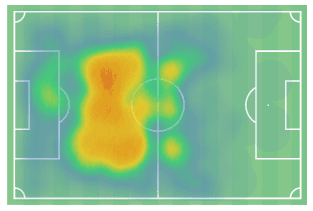
Igor Zubeldia is the base of that midfield, affording the other two the freedom to push higher in the attack. As you can see in his heat map, his primary concern is adding a layer of protection for the backline. Real Sociedad enjoy the second-most possession in the league (57.1%) and one of the better counter-pressing teams in La Liga with an 8.72 PPDA (passes per defensive action). One of the vulnerabilities of this side is when that counter-press is beaten. The team has a tendency to overcommit in the counter-press without getting numbers behind the ball. That was a significant problem during the first half of the season. With Zubeldia sitting further back, Sociedad now have a ball-winner in front of the backline and a deep outlet if the counter-press is successful.
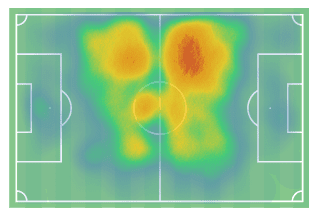
If there was one player in the squad who fell under the radar while the young attackers stole the limelight, it’s Mikel Merino. No longer in their shadow, he’s perhaps the most important player on the team. His two-way play at the #8 is essential for this squad. Merino ranks 8th in La Liga with 40 through passes and tied for 6th with 213 defensive duels. You can typically find him in the left-half space or wing, though he’s no stranger to the middle. Given the attacking responsibilities of his #10, Merino is very likely to move centrally to snuff out an attack. He’s the type of player who can do most things at a reasonably high level. Without a gaping flaw in his game, he’s easily the most rounded player on the squad.
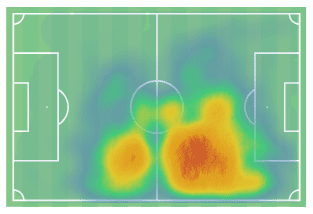
That doesn’t mean Martin Ødegaard isn’t the best overall player. Since moving centrally into the #10 role, Ødegaard has provided an afternoon’s worth of highlight reels. In the midst of a two-year loan from Real Madrid, Ødegaard has lit up the league with consistently high levels of play. Look at any La Liga passing category and you’ll find the same two players at the top of the list: Lionel Messi and Ødegaard. His 63 through passes rank only behind Messi. Another plus is that, unlike most #10s, he’s willing to put in the work defensively, earning 4.3 recoveries per game, 2.7 of which come in the opposition’s half. His ability to break an opponent’s ranks have earned him extra attention, allowing Merino to set into a larger role and giving the forwards more space to operate. In drawing the attention of the opponent, Ødegaard has helped his teammates experience greater success, which is why La Real are enjoying this fine run of form.
Variability up top
In its first 20 matches, Real Sociedad were held to an xG lower than 1 in 9 matches. Three additional games fell in the 1 to 1.25 xG range, so, despite the plethora of excellent attacking options, shot quality was an issue. The side only averages 10.89 shots per game, 4 of which find the target. Those numbers are roughly equivalent to what they’re conceding per game.
If not for the recent abysmal performance by a heavily-rotated starting XI against Leganes, La Real’s shots versus shots conceded per game would stand at 12 to nine in the previous seven matches. Goals to goals against strongly favours Sociedad during this seven window period. They’ve scored an average of 1.71 goals per game while conceding only 0.71. It is important to note that they are overperforming their xG (1.40) and xGA (1.15) during that window. While that does point to some degree of good fortune, it’s also an indicator that Real Sociedad’s young stars found themselves in a run of great form and were clinical in attack.
One of the reasons is the versatility up top. At the moment, Alguacil has a good problem on his hands. Play the more experienced Willian José or the Swedish starlet, Alexander Isak. José has nine goals on 6.47 xG, which represents a 28% overperformance in that category. Isak’s performance is almost identical, producing seven goals on 5.17 xG, equating to a 26% overperformance value. Isak averages 0.54 goals and 0.4 xG per 90 minutes. Circling back to José, the numbers bear a striking resemblance. The Brazilian averages 0.52 goals and 0.38 xG per 90 minutes. Given the comparable production of the two, Alguacil can easily rotate the forwards or ride the hot-foot.
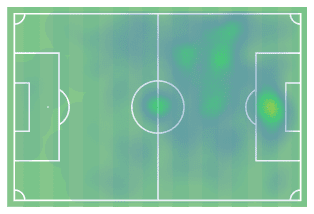
Early in the season, José received the bulk of the playing time. From mid-September to the end of November, he managed seven goals in an 11 game stretch. That prompted interest from the EPL, most commonly from Tottenham. He’s a different kind of forward than Isak. José is built like a mountain, though with exceptional technical ability. You will frequently see him dropping into the left-half space to participate in the build-up and interchange with Mikel Oyarzabal. As the play draws near the box, he frequently positions himself for a pass played in front of the retreating defence. While opponents recover to the six, he’s happy to unleash a shot for the penalty spot. Both of these points are evident from his heat map. You can see him more central in the build-up, moving to the left-half space with the progression to the next attacking phase and finish the play near the penalty spot.
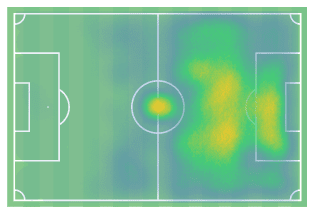
With his spindly build and quick feet, Isak is not so much a target forward as an attacking #9 who frequently looks to get behind the defence and utilize the dribble. Studying his heat map, Isak is very much a central presence. His movements are designed to keep him close to goal and occupy two central defenders. Stretching back to the mid-December draw against Barcelona, Isak has five goals on 3.61 xG. That’s an impressive 0.74 goals and 0.54 xG per 90 minutes. The Scandinavian pairing of Isak and Ødegaard has been a major positive for the club as Isak is a willing runner, able to contest through balls at a higher efficiency than José. This ability to get behind the defence is an ideal fit for Ødegaard’s pinpoint passing. Plus, Isak’s ability to stretch the lines gives Ødegaard and the two wings additional space in the centre and half-spaces.
Improved defensive performances
In their last seven games, Sociedad has averaged a 1.15 xGA. Taking away the three penalty kicks, two of which were difficult, though correct, calls, the xGA drops to a total of 5.96, good for an average of .85 xGA per game. They’re still having issues late in the game, allowing 12 of 33 goals in the final 20 minutes, but the overall play has greatly improved. As mentioned earlier, Zubeldia’s play at #6 is a big reason for the club’s recent successes. However, analysis of the emerging centre-back tactics reveals an additional indicator for the team’s success.
Robin Le Normand has laid claim to a starting role at centre-back, but, perhaps more interesting, is the return of Aritz Elustondo. In a season that’s seen a groin injury and concussion limit his availability, Elustondo has regained at least a timeshare with Diego Llorente. Among the top three centre-back options, Elustondo has recorded the highest WhoScored rating this season. His mobility and intelligence at the back make for a great pairing with the brawn of Le Normand. Elustondo’s return to health has given Alguacil some interesting tactical options at centre-back.
At the moment, Llorente is the preference against teams that will push for the possession advantage, whereas Elustondo starts when the side expects to primarily defend against the counterattack. It’s more a matter of mobility vs size. Whichever player has the better tactical matchup is the one to start. That tactical versatility has led the way to improved performances at the back, allowing each defender to play within his strengths.
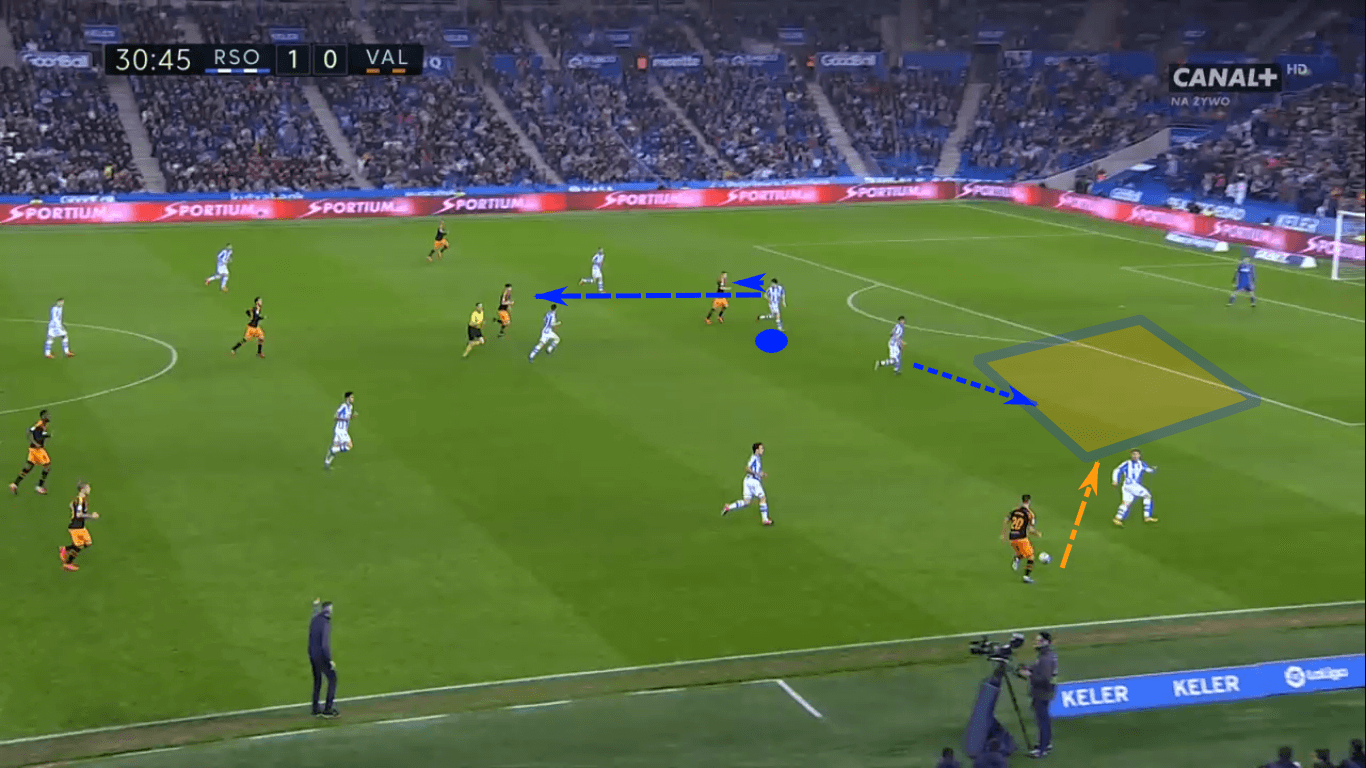
In the recent match against Valencia, we got a look at the tactics that will necessitate Elustondo’s starting place. This sequence starts with the young Spanish sensation, Ferran Torres, engaging Nacho Monreal in a 1v1 duel. Knowing the ability of the winger and the likelihood that Le Normand would have to slide into the half-space to offer coverage, Elustondo checks his shoulder to identify possible runners into the box. Kevin Gameiro is right behind him and Carlos Soler is quickly making ground through the central channel. Elustondo knows that once Le Normand leaves, there’s a lot of ground to cover.
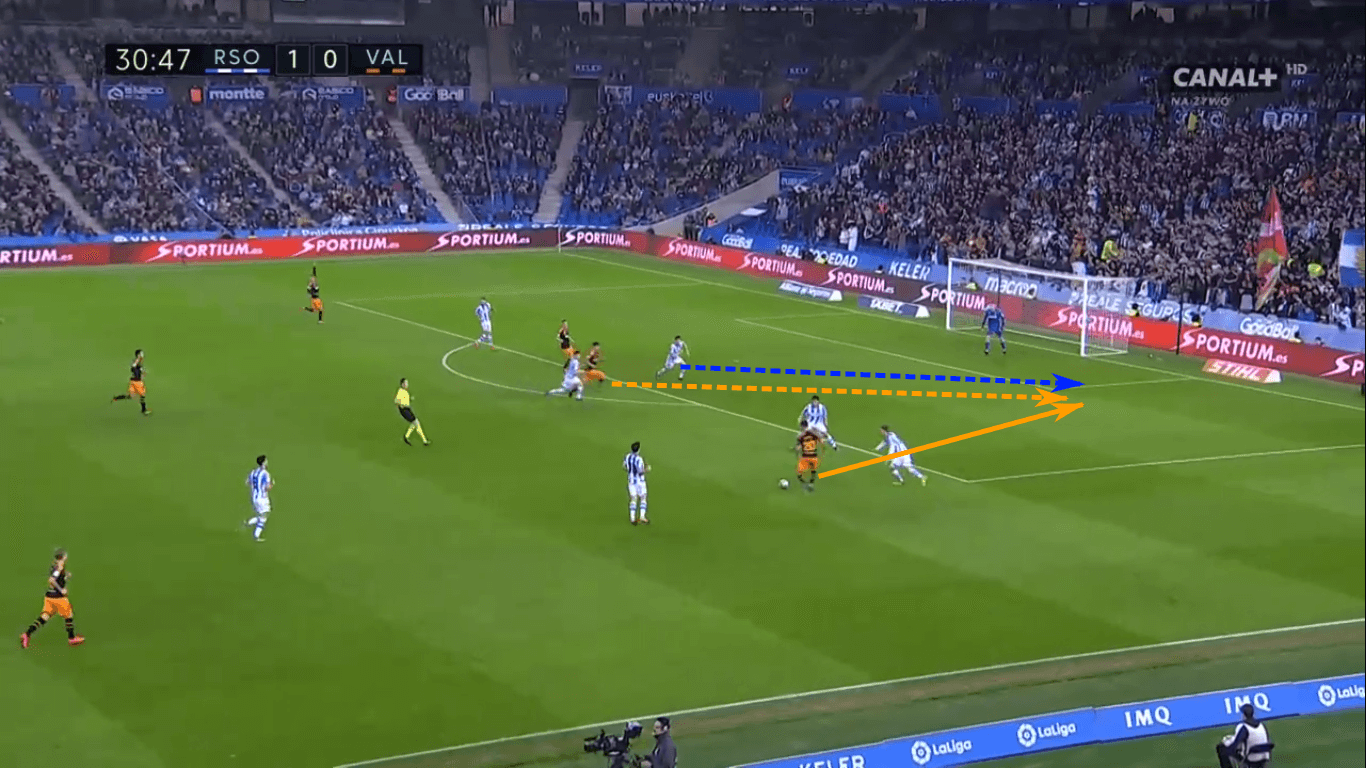
Torres split the defence, playing Soler through the space Le Normand vacated. Since Elustondo read the run seconds earlier, he was prepared to pursue Soler and prevent the negative pass to Gameiro.
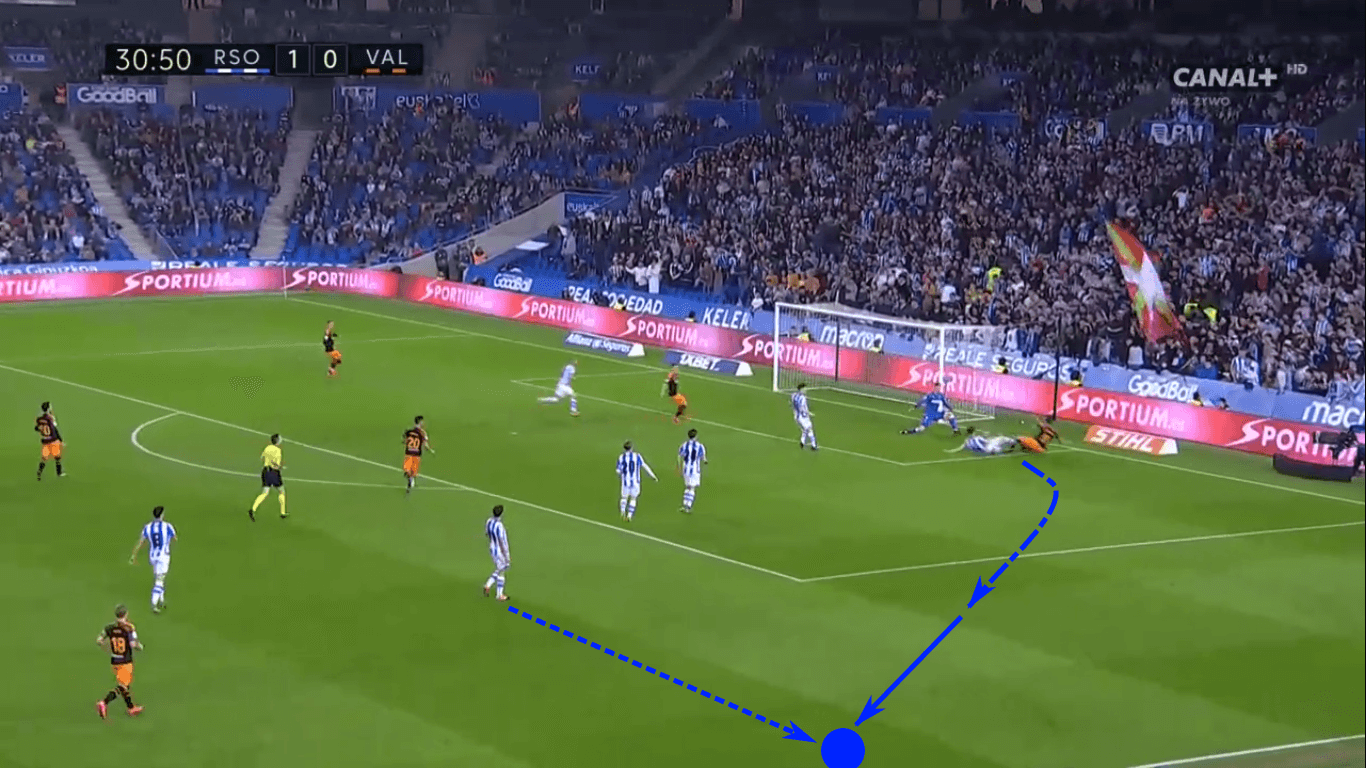
Elustondo not only wins the tackle but also manages to keep the ball in play and relaunch the attack with a pass to Oyarzabal. The centre-backs excellent read of the play and mobility to cover the ground are key reasons why you’ll see him feature against sides that prefer to counterattack or play behind the defence.
Conclusion
Should we see La Liga resume play and finish out the season, Real Sociedad have a tough road ahead of them. Among the teams competing for a UEFA Champions League berth, La Real have the most difficult fixture. Seven of its remaining 12 matches come against the top half of the table, four of which are on the road. Comparing matches against the top half of the table and which of those are away, Sevilla have five and three, Getafe have five and two, Atletico have four and three, then Valencia with five and four, respectively.
The positives for Real Sociedad are that they are consistently in the third to sixth range in most prominent statistical categories. Consistency across the board is one of the side’s keys strengths. Among their contenders for the top four, all the others have a glaring weakness or lack of depth to contend with. The road is difficult and certainly made more complicated by the suspension of play, but, if La Liga finishes out the season, Alguacil and Txuri-urdinak have a strong chance to bring Champions League back to the Anoeta.




Comments